Urbanization - Physical Habitat
Physical Habitat in Urban Streams
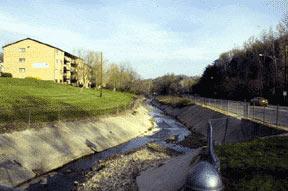 Courtesy of USFWSUrbanization can alter the geomorphologic and vegetative structural features of stream channels—that is, their physical habitat.
Courtesy of USFWSUrbanization can alter the geomorphologic and vegetative structural features of stream channels—that is, their physical habitat.
Studies have reported many physical habitat alterations associated with urbanization, including (but not limited to):
- Increased direct channel modification (e.g., piping and burial)
[Elmore and Kaushal 2008, Roy et al. 2009] - Increased channel enlargement
[Booth and Jackson 1997, Trimble 1997, Hession et al. 2003, Chin 2006, Allmendinger et al. 2007] - Increased channel incision
[Booth and Jackson 1997, Hardison et al. 2009] - Decreased woody debris
[Finkenbine et al. 2000, King et al. 2005, Horwitz et al. 2008] - Altered geomorphologic units (Figure 38)
[Gregory et al. 1994, Riley et al. 2005, Shoffner and Royall 2008] - Altered streambed substrate composition (Figure 39)
[Finkenbine et al. 2000, Pizzuto et al. 2000, Walters et al. 2003, Roy et al. 2005, Blakely et al. 2006] - Decreased habitat complexity
[Riley et al. 2005, Blakely et al. 2006, Gooseff et al. 2007]
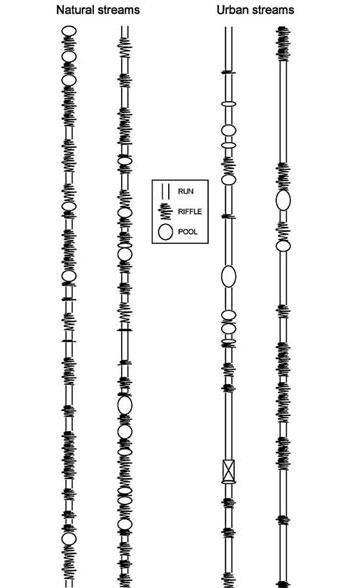 Figure 38. Schematic representation of the run, riffle and pool structure in two natural and two urban streams in southern California (the rectangle with an X in one of the urban streams represents a culvert). Urban streams had longer habitat segments, higher percentages of runs, and reduced habitat complexity.
Figure 38. Schematic representation of the run, riffle and pool structure in two natural and two urban streams in southern California (the rectangle with an X in one of the urban streams represents a culvert). Urban streams had longer habitat segments, higher percentages of runs, and reduced habitat complexity.From Riley SPD et al. 2005. Effects of urbanization on the distribution and abundance of amphibians and invasive species in southern California streams. Conservation Biology 19(6):1894-1907. Reprinted with permission.
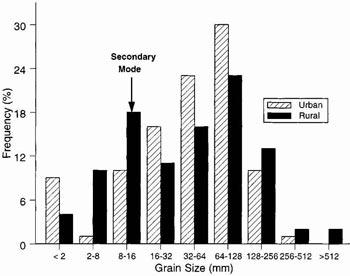 Figure 39. Typical grain-size histograms from urban and rural catchments. The frequency of < 2 mm particles more than doubled in urban streams. Rural streams had a secondary sediment size mode at 8-16 mm. This secondary mode was absent in urban channels, suggesting that these substrate sizes were selectively removed from urban streams.
Figure 39. Typical grain-size histograms from urban and rural catchments. The frequency of < 2 mm particles more than doubled in urban streams. Rural streams had a secondary sediment size mode at 8-16 mm. This secondary mode was absent in urban channels, suggesting that these substrate sizes were selectively removed from urban streams.From Pizzuto JE et al. 2000. Comparing gravel-bed rivers in paired urban and rural catchments of southeastern Pennsylvania. Geology 28(1):79-82. Reprinted with permission.
See the Physical Habitat module for more general discussion of physical habitat in streams (i.e., not just urban streams).
Channel Enlargement with Urbanization
- Increased sediment supply initially, followed by decreased sediment supply over time
- Increased sediment transport capacity (i.e., stream discharge)
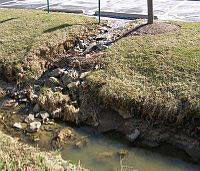 Photo is courtesy of Susan Cormier, USEPA. Early in urban development, soil disturbance commonly increases sediment supply and leads to channel aggradation (Wolman 1967, Chin 2006). Once development is more established, imperviousness and stream discharge commonly increase and sediment supply decreases, leading to channel degradation or incision (Wolman 1967, Chin 2006).
Photo is courtesy of Susan Cormier, USEPA. Early in urban development, soil disturbance commonly increases sediment supply and leads to channel aggradation (Wolman 1967, Chin 2006). Once development is more established, imperviousness and stream discharge commonly increase and sediment supply decreases, leading to channel degradation or incision (Wolman 1967, Chin 2006).
Thus, streams in urban catchments tend to widen and deepen. Trimble (1997) observed this process in Borrego Canyon Wash, CA (Figure 40), where erosion rates downstream of an urbanizing area were 20 m3 m-1 yr-1, versus 0.47 m3 m-1 yr-1 at a less urbanized site.
In lowland streams of western Washington, Booth and Jackson (1997) found that channels generally exhibited stability thresholds (below which there was little or no bed and bank erosion) at 10% effective impervious area, or at increased discharge such that 10-year discharge in a forested catchment equaled 2-year discharge under current catchment land use (Figure 41).
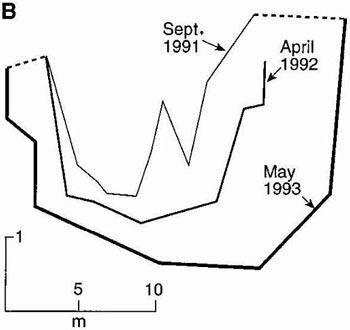 Figure 40. Surveyed stream channel cross-sections taken downstream of an urbanizing area on Borrego Canyon Wash, CA.
Figure 40. Surveyed stream channel cross-sections taken downstream of an urbanizing area on Borrego Canyon Wash, CA. From Trimble SW. 1997. Contribution of stream channel erosion to sediment yield from an urbanizing watershed. Science 278:1142-1144. Reprinted with permission from AAAS.
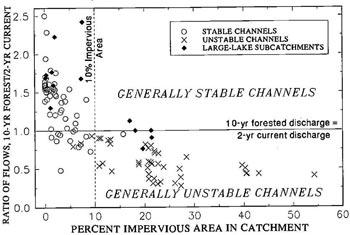 Figure 41. Observed stable and unstable channels, plotted by % effective impervious area in catchment and magnitude of simulated flow increases (ratio of modeled 10-year forested to 2-year current or urbanized discharges).
Figure 41. Observed stable and unstable channels, plotted by % effective impervious area in catchment and magnitude of simulated flow increases (ratio of modeled 10-year forested to 2-year current or urbanized discharges). From Booth DB & Jackson CR. 1997. Urbanization of aquatic systems: degradation thresholds, stormwater detection, and the limits of mitigation. Journal of the American Water Resources Association 33(5):1077-1090. Reprinted with permission.
- Age and extent of urban development
- Riparian condition
- Connectedness of impervious areas and conveyance of stormwater to channel
- Degree of channel entrenchment
- Erodibility of bed and bank material
Effects of Road Crossings
- Altered stream discharge patterns due to increased imperviousness and stormwater runoff
- Increased contaminant loads due to accumulation on and runoff from road surfaces
At road crossings, roads can directly impact stream ecosystems, for example by altering channel geomorphology, increasing sedimentation, and impeding fish and invertebrate movement. In addition, stormwater drains often run along roads, and road crossings frequently are points of stormwater discharge to streams. Thus, road crossing density can be a good predictor of stream biotic integrity, with biotic condition decreasing as the number of road crossings increases (Alberti et al. 2007, Carlisle et al. 2009).
However, not all road crossing types have the same effect. For example, Blakely et al. (2006) examined how different road crossing types affected movement of adult caddisflies in New Zealand streams. They found that road culverts were barriers to caddisfly dispersal: the number of adults caught immediately upstream of culvert crossings was much lower than the number caught at control sites downstream (Figure 42). Bridges, which provided more open spans over streams, did not inhibit movement. Fish movement has shown similar bridge vs. culvert patterns (Benton et al. 2008).
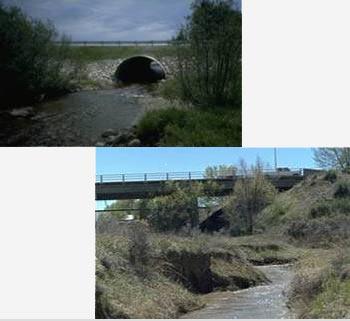 Example culvert (top) and bridge (bottom) road crossings.
Example culvert (top) and bridge (bottom) road crossings. Photo courtesy of Tetra Tech a contractor to the USEPA.
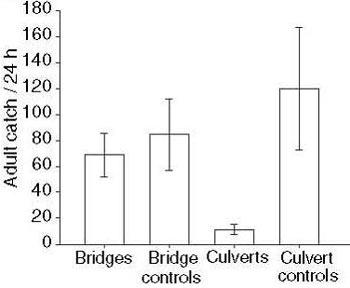 Figure 42. Number of adult caddisflies caught directly upstream of bridges and culverts (n = 8), vs. at control sites 50 m downstream.
Figure 42. Number of adult caddisflies caught directly upstream of bridges and culverts (n = 8), vs. at control sites 50 m downstream. From Blakely TJ et al. 2006. Barriers to the recovery of aquatic insect communities in urban streams. Freshwater Biology 51:1634-1645. Reprinted with permission.
Bed Substrates and Biotic Condition
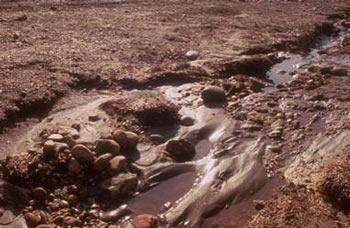 Increased erosion and sediment runoff from disturbed soils. Urbanization typically affects both sediment supply and transport capacity in streams, resulting in altered substrate composition and stability—both of which are key factors influencing stream biotic communities (see the Sediment module for further discussion of sediment as a stressor).
Increased erosion and sediment runoff from disturbed soils. Urbanization typically affects both sediment supply and transport capacity in streams, resulting in altered substrate composition and stability—both of which are key factors influencing stream biotic communities (see the Sediment module for further discussion of sediment as a stressor).
- Increased fine sediment
[Hogg and Norris 1991, Morley and Karr 2002, Roy et al. 2005, Taulbee et al. 2009, Walters et al. 2009] - Increased embeddedness and armoring
[Borchardt and Statzner 1990, Blakely et al. 2006, Chin 2006, Walters et al. 2009] - Decreased substrate stability
[Pedersen and Perkins 1986] - Decreased substrate complexity and heterogeneity
[Morley and Karr 2002, Blakely et al. 2006]
For example, Morley and Karr (2002) found that invertebrate biotic integrity (B-IBI) scores and taxa richness metrics increased with substrate size and roughness, but that these substrate parameters decreased with urbanization (Table 7).
| Parameter | Substrate Measure | ||
|---|---|---|---|
| D16* | D50* | Roughness* | |
| Urbanization, n | 17 | 17 | 17 |
| % Sub-basin | -0.20 | -0.35 | -0.60** |
| % Local | -0.12 | -0.49 | -0.70 |
| Biotic condition, n | 18 | 18 | 18 |
| B-IBI | +0.27 | +0.12 | +0.51 |
| Total taxa richness | +0.34 | +0.17 | +0.43 |
| EPT richness | +0.59 | +0.41 | +0.50 |
| Clingers richness | +0.60 | +0.39 | +0.52 |
| * D16 and D50 refer to the substrate diameter below which 16% and 50% of particles are smaller, respectively. Roughness was calculated as the 84% particle diameter divided by bankfull depth. ** Coefficients in italics had p < 0.10; coefficients in bold had p < 0.05. Modified from Morley SA and Karr JR. 2002. Assessing and restoring the health of urban streams in the Puget Sound basin. Conservation Biology 16(6):1498-1509. |
|||
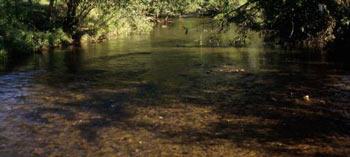 However, fine sediments are not always higher in urban streams. Fines may be scoured from these systems as stream discharge increases with impervious cover, resulting in coarser, more armored streambeds (Chin 2006).
However, fine sediments are not always higher in urban streams. Fines may be scoured from these systems as stream discharge increases with impervious cover, resulting in coarser, more armored streambeds (Chin 2006).
